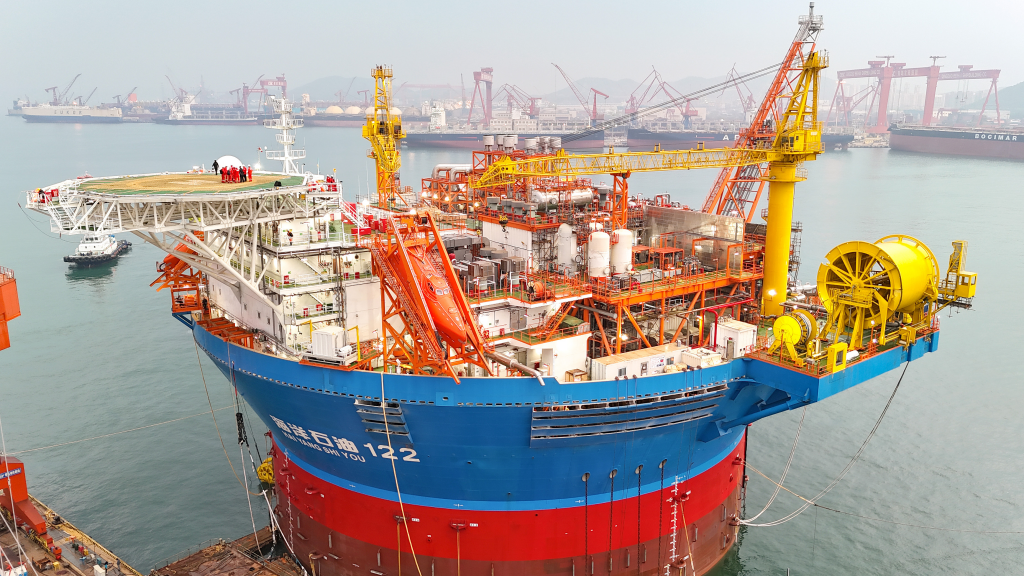Floating Production Storage And Offloading Vessel

The seas, once thought to be insurmountable barriers, are now dotted with engineering marvels that unlock the planet's energy resources. At the forefront of this offshore revolution stands the Floating Production Storage and Offloading (FPSO) vessel, a sophisticated behemoth reshaping the landscape of oil and gas extraction. Its presence signifies not just technological advancement, but also a complex interplay of economic opportunity, environmental responsibility, and geopolitical strategy.
FPSOs represent a multi-billion dollar investment and are critical to unlocking deep-water and remote offshore oil and gas reserves. These vessels serve as self-contained production facilities, capable of extracting, processing, storing, and offloading hydrocarbons directly to tankers. This article delves into the critical role of FPSOs in the global energy market, exploring their technology, economic impact, environmental considerations, and future prospects, drawing from industry reports, expert analysis, and official statements to provide a comprehensive overview.
The Technological Prowess of FPSOs
An FPSO is more than just a ship; it is a floating factory equipped with a complex array of technologies. This includes separation equipment to isolate oil, gas, and water; stabilization units to remove impurities; and compression systems for gas reinjection or export. These systems allow for continuous production in even the most challenging marine environments.
The hulls of FPSOs are designed for long-term station keeping, often utilizing sophisticated mooring systems that can withstand extreme weather conditions. Dynamic Positioning (DP) systems are also employed, using thrusters and sensors to maintain the vessel's position without the need for anchors.
Types of FPSO Vessels
FPSOs come in various designs, each tailored to specific operational requirements and environmental conditions. These include ship-shaped vessels, cylindrical platforms, and semi-submersible units, each with distinct advantages regarding stability, storage capacity, and cost-effectiveness.
Ship-shaped FPSOs are generally preferred for their large storage capacity and ease of mobility, making them suitable for a wide range of field developments. Cylindrical and semi-submersible designs, on the other hand, are often favored for their enhanced stability in harsh environments, such as the North Sea or offshore Brazil.
Economic Impact and Global Deployment
The deployment of FPSOs has opened up previously inaccessible offshore regions for oil and gas exploration and production. This has had a profound impact on the economies of countries with significant offshore reserves, such as Brazil, Nigeria, and Angola.
FPSOs represent significant capital investments, creating numerous jobs in engineering, construction, and operation. Rystad Energy estimates that global FPSO spending will continue to grow, driven by increasing demand for offshore oil and gas production. This growth supports employment and technological innovation.
Beyond direct employment, FPSO projects stimulate economic activity in related industries, including shipbuilding, equipment manufacturing, and marine services. These projects often involve international collaborations, fostering technology transfer and cross-border investments.
Environmental Considerations and Sustainability
The operation of FPSOs carries inherent environmental risks, including the potential for oil spills, gas leaks, and waste discharge. Stringent safety regulations and environmental management systems are crucial to mitigating these risks.
Companies operating FPSOs are increasingly investing in technologies to reduce their environmental footprint. This includes implementing closed-loop systems to minimize waste discharge, using more efficient energy sources, and deploying advanced monitoring systems to detect and respond to leaks promptly.
However, environmental advocacy groups often voice concerns about the long-term environmental impact of FPSO operations, particularly in sensitive marine ecosystems. Stricter regulations and independent oversight are essential to ensure that FPSO operations adhere to the highest environmental standards.
The industry is also exploring alternative energy sources for FPSO operations, such as wind and solar power, to reduce reliance on fossil fuels. Furthermore, there's growing interest in carbon capture and storage (CCS) technologies to mitigate greenhouse gas emissions from FPSO operations.
Safety and Regulatory Framework
Given the complex and hazardous nature of FPSO operations, robust safety regulations and emergency response plans are paramount. Regulatory bodies such as the International Maritime Organization (IMO) and national authorities establish stringent standards for FPSO design, construction, and operation.
Regular inspections and audits are conducted to ensure compliance with these regulations, and operators are required to develop comprehensive safety management systems. These systems cover everything from equipment maintenance and personnel training to emergency response procedures.
The Macondo disaster in the Gulf of Mexico highlighted the importance of rigorous safety oversight in the offshore oil and gas industry. Since then, there has been increased scrutiny of FPSO safety protocols and a greater emphasis on independent verification of safety systems.
The Future of FPSOs
FPSOs are expected to remain a vital part of the global energy landscape for decades to come. As easily accessible onshore oil and gas reserves dwindle, the industry will increasingly rely on offshore resources, particularly in deep-water and ultra-deep-water environments.
Technological advancements are driving the development of larger, more efficient FPSOs capable of operating in even harsher conditions. Digitalization and automation are also playing a key role, enabling remote monitoring and control of FPSO operations, improving safety and efficiency.
The energy transition is creating new opportunities for FPSOs. They can be repurposed for other offshore activities, such as offshore wind power generation and hydrogen production. The adaptability of FPSOs ensures their continued relevance in a rapidly changing energy landscape.
While the role of FPSOs in the energy mix may evolve over time, their technological capabilities and economic significance will likely ensure their place as crucial infrastructure for decades to come. Continuous innovation, rigorous safety standards, and a commitment to environmental responsibility will be key to ensuring their sustainable operation and long-term contribution to global energy security.




